

Designation:Bioroids |

|
||||
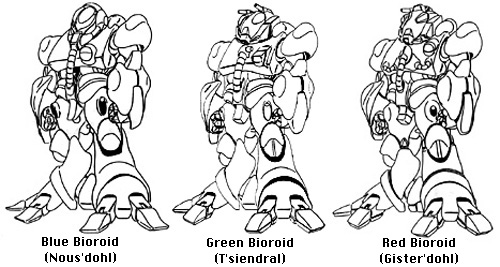
|
|||||
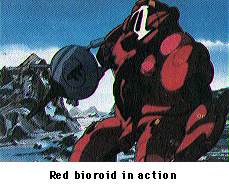
| Height: | 7.0 m |
| Depth: | 2.2 m |
| Breadth : | 3.0 m |
| Weight: | 11.1 metric tons |
| Weight: | 12.0 metric tons |
| Weight: | 12.5 metric tons |
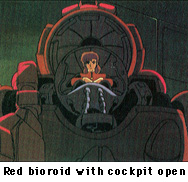
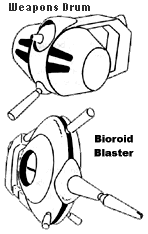
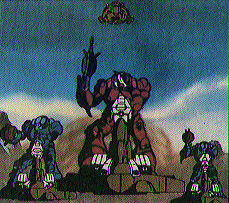
The armor of the Blue Bioroid is composed of an advanced titanium-steel alloy. The armor stops all small arms and heavy infantry weapons fire, provides excellent resistance to light mecha-mounted weaponry, such as the Zentraedi 22.3mm HE autocannon round, and fair resistance to medium mecha-mounted weaponry, such as the Valkyrie's 55mm APFSDS round.
The armor on the other Bioroids is a low-mass composite-materials Chobham plating that was later emulated by Earth militaries for their mecha. Aside from the respectable protection provided against projectiles, missiles, and other kinetic weapons, this armor is also resistant to plasma globes (annihilation discs), lasers, and to a lesser extent, particle guns, owing to the fact that the armor can flake off and evaporate in layers under fire from such high-energy weapons, taking much of the weapon's energy and converting it into the latent heat of sublimation in the armor.
The armor on the Green and Scout Bioroids stops all small arms, heavy infantry weapons fire, and light mecha-mounted weaponry, and provides fair to good resistance to medium mecha-mounted weaponry, such as the Valkyrie's 55mm APFSDS round. The armor on the Red Bioroid and the Invid Fighter stops all small arms, heavy infantry weapons fire, and light mecha-mounted weaponry, and provides good resistance to medium mecha-mounted weaponry, and poor resistance to heavy mecha-mounted weaponry. The armor on the Invid Fighter is marginally superior to that on the Red Bioroid.
The Bioroids provide full protection from nuclear, biological, and chemical hazards, using a sealed overpressure cockpit environment. The internal consumables supplies can provide atmosphere for two days maximum.
NOTE: The Bioroids' redundant systems and advanced design made them exceedingly capable of coping with battle damage, and the total protection afforded by the Bioroid was hence more than the armor data would suggest.
The Bioroid mecha series is the most technologically advanced mecha line to date. The series was developed as a general purpose mecha for the Tirolian warrior clones, who formed the combat and guard troops directly under the Robotech Masters themselves. The requirements for this mecha were different than those for the Zentraedi mecha, for where the Zentraedi were created to conquer or to destroy, the Bioroids were as much meant to police and to protect as to engage in combat.
The Scientist triumvirates then developed an anthropomorphic mecha, which could carry armaments if needed in gun pods, to be equipped with an anti-gravity Skysled if mobility was necessary. This gave the Bioroids a very flexible configuration. In addition, the mecha was given the most advanced control and other technologies available. The cockpit was built as a sphere in which the pilot sat in a sort of yoga-attitude. Neural interfaces were built into the material of the cockpit, and were capable of rerouting the pilot's motor controls to the Bioroid. Thus, the Bioroid was 'worn' as if it were the pilot's own body, greatly increasing reaction time. This system required that the pilot have biological 'diodes' built into his motor nervous system, meaning that only specially configured clones could pilot this mecha. All internal systems were made multiply redundant, to such a degree that some SC officers have been known to say that only a direct hit to a vital spot like the pilot or generator could stop a Bioroid. Any other hit would, at most, slow it down. Needless to say, the Bioroid's sensor suite was state of the art.
There were five different series of Bioroids, as well as a little-known
"Worker Bioroid", not detailed here. Most common was the standard combat
Bioroid, always painted blue. This Bioroid had a reasonable armor protection,
but it was not the best available. The blue's armor was, however, far cheaper
to create than the armor on the other Bioroids, and since the Masters were
about as indifferent to their clone soldiers as to their Zentraedi soldiers,
the blue Bioroid was produced in great numbers at relatively low expense.
Because of the greater value of the clone officers to the Masters, it was
decided that these should be issued more durable Bioroids than the standard
blue. Thus the guard Bioroid was created, known after its paint job as the
green Bioroid. This Bioroid was one ton heavier due to the improved armor
protection, and thus also featured an enhanced generator to keep the same
level of performance. Production of this series was rather limited, for quite
soon after their introduction, the Scientists developed an even better armor
type, that was as light and thick as the armor on the green Bioroid, but
marginally cheaper to produce and better in performance than the green's
armor. Shortly afterwards, the well-known Bioroid Leader (painted red) was
walking off the assembly lines, derived from the green. The green leaders
were kept in service, but were inferior in combat capacity to the red
Bioroids, and thus only used for secondary tasks (like guarding the Masters'
ships when the most red and blue Bioroids were not on board, or guarding the
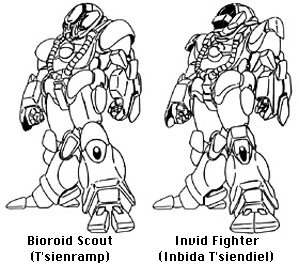 less likely avenues of attack). Less familiar was what has come to be known
as the "Scout" Bioroid. Also painted blue, the Bioroid Scout can be
distinguished by the three phased-array radar suites on the head, and the
distinctive new body-type. The Bioroid Scout was equipped with the most
extensive and most powerful sensors ever installed on a mecha, though
virtually all details have been kept classified by the United Earth Government,
and are not available as of this writing. The Bioroid Scout was often seen
escorting the battlefield commander, often a Red Bioroid, though its
blue color made it difficult to distinguish at a distance from the standard
blue suits - and this anonymity lent it some protection from selective
targeting in the thick of battle. The last Bioroid deserving attention is
the Invid Fighter. This new design was based on an uparmored Bioroid Scout,
but was equipped with half a ton of additional psionic relays in a new head
that lacked the Scout's extensive sensory equipment. This enabled the
Bioroid pilot to remain in constant telepathic contact with his triumvirate
brothers, and made them act in concert with each other, greatly increasing
their combat effectiveness. This made them better suited to fight the large
numbers of Invid that were threatening to wipe out the Masters. The Invid
Fighters had one disadvantage, however: the remodeled head, with its extra
electronics, was more vulnerable to attack than the heads of the other
Bioroids, and destruction of the head meant destruction of the psionic link
between the clone-brothers, and often even of the entire Bioroid because of
a power surge from the remains of the head into the powerplant. Some
prototypes of what would become the Invid Fighter, sans the triumvirate-link
upgrades, were left on Tirol at the date of the Masters' departure for
Earth, and these saw service in the brief and unsuccessful defense of Tirol
by its citizens. However, the full Invid Fighter was a product of the
Second Robotech War, and mainly saw action against the Southern Cross, not
the Invid.
less likely avenues of attack). Less familiar was what has come to be known
as the "Scout" Bioroid. Also painted blue, the Bioroid Scout can be
distinguished by the three phased-array radar suites on the head, and the
distinctive new body-type. The Bioroid Scout was equipped with the most
extensive and most powerful sensors ever installed on a mecha, though
virtually all details have been kept classified by the United Earth Government,
and are not available as of this writing. The Bioroid Scout was often seen
escorting the battlefield commander, often a Red Bioroid, though its
blue color made it difficult to distinguish at a distance from the standard
blue suits - and this anonymity lent it some protection from selective
targeting in the thick of battle. The last Bioroid deserving attention is
the Invid Fighter. This new design was based on an uparmored Bioroid Scout,
but was equipped with half a ton of additional psionic relays in a new head
that lacked the Scout's extensive sensory equipment. This enabled the
Bioroid pilot to remain in constant telepathic contact with his triumvirate
brothers, and made them act in concert with each other, greatly increasing
their combat effectiveness. This made them better suited to fight the large
numbers of Invid that were threatening to wipe out the Masters. The Invid
Fighters had one disadvantage, however: the remodeled head, with its extra
electronics, was more vulnerable to attack than the heads of the other
Bioroids, and destruction of the head meant destruction of the psionic link
between the clone-brothers, and often even of the entire Bioroid because of
a power surge from the remains of the head into the powerplant. Some
prototypes of what would become the Invid Fighter, sans the triumvirate-link
upgrades, were left on Tirol at the date of the Masters' departure for
Earth, and these saw service in the brief and unsuccessful defense of Tirol
by its citizens. However, the full Invid Fighter was a product of the
Second Robotech War, and mainly saw action against the Southern Cross, not
the Invid.
Though the Bioroids are most commonly referenced by color (or in the case of the latter two, function), the Tiresian names are also encountered. The Blue Bioroid is called Nous'dohl ("Warrior"), the Green T'siendral ("Sentinel") and the Red Gister'dohl ("Warlord"). Among the Tirolians, the Bioroid Scout was called T'sienramp ("Observer"). "Invid Fighter" is a direct translation of the Tiresian name, Inbida T'siendiel, though this mecha is also sometimes called the Lotus as an approximation to the Tiresian nickname, the word for the tripartate blossoms of the aquatic variety of the Invid Flower of Life.

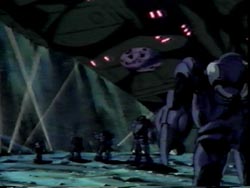
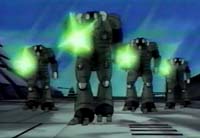
Go to Bioroid Gallery.
Addendum: Anti-gravity Skysled
Return to Tirolian Index
Go to Robotech Reference Guide Home Page
Robotech (R) is the property of Harmony Gold. This document is in no way intended to infringe upon their rights.
Content by Peter Walker and Pieter Thomassen, with Rob Morgenstern
Copyright © 1997, 1995 Robert Morgenstern, Peter Walker, Pieter Thomassen
Last Updated: Tuesday, November 18, 1997 10:46 AM